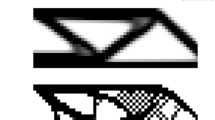Abstract
This article presents a new procedure for the layout design of reinforcement in concrete structures. Concrete is represented by a gradient-enhanced continuum damage model with strain-softening and reinforcement is modeled as elastic bars that are embedded into the concrete domain. Adjoint sensitivity analysis is derived in complete consistency with respect to path-dependency and the nonlocal model. Classical truss topology optimization based on the ground structure approach is applied to determine the optimal topology and cross-sections of the reinforcement bars. This approach facilitates a fully digital work flow that can be highly effective, especially for the design of complex structures. Several test cases involving two- and three-dimensional concrete structures illustrate the capabilities of the proposed procedure.

















Similar content being viewed by others
References
Batoz JL, Dhatt G (1979) Incremental displacement algorithms for nonlinear problems. Int J Numer Methods Eng 14:1262–1267
Bažant ZP, Belytschko TB, Chang T (1984) Continuum theory for strain-softening. ASCE J Eng Mech 110(12):1666–1692
Bendsøe MP (1989) Optimal shape design as a material distribution problem. Struct Optim 1:193–202
Bendsøe MP, Sigmund O (2003) Topology optimization—theory, methods and applications. Springer, Berlin
Bogomolny M, Amir O (2012) Conceptual design of reinforced concrete structures using topology optimization with elasto-plastic material modeling. Int J Numer Methods Eng 90(13):1578–1597. doi:10.1002/nme.4253
Bruggi M (2009) Generating strut-and-tie patterns for reinforced concrete structures using topology optimization. Comput Struct 87(23–24):1483–1495
Červenka J, Papanikolaou VK (2008) Three dimensional combined fracture-plastic material model for concrete. Int J Plast 24(12):2192–2220
Chang T, Taniguchi H, Chen W (1987) Nonlinear finite element analysis of reinforced concrete panels. ASCE J Struct Eng 113:122–140
Dombernowsky P, Søndergaard A (2009) Three-dimensional topology optimisation in architectural and structural design of concrete structures. In: Proceedings of the International Association for Shell and Spatial Structures (IASS) symposium, Valencia, Spain
Drucker DC, Prager W (1952) Soil mechanics and plastic analysis or limit design. Q Appl Math 10(2):157–165
Feenstra PH, de Borst R (1996) A composite plasticity model for concrete. Int J Solids Struct 33:707–730
fib Task Group 44 (2008) Practitioners’ guide to finite element modelling of reinforced concrete structures. International Federation for Structural Concrete (fib), Lausanne, Switzerland
Kato J, Ramm E (2010) Optimization of fiber geometry for fiber reinforced composites considering damage. Finite Elem Anal Des 46(5):401–415
Kato J, Lipka A, Ramm E (2009) Multiphase material optimization for fiber reinforced composites with strain softening. Struct Multidisc Optim 39(1):63–81
Kwak HG, Noh SH (2006) Determination of strut-and-tie models using evolutionary structural optimization. Eng Struct 28(10):1440–1449
Lemaître J, Desmorat R (2005) Engineering damage mechanics. Springer, Berlin
Liang Q, Xie Y, Steven G (2000) Topology optimization of strut-and-tie models in reinforced concrete structures using an evolutionary procedure. ACI Struct J 97(2):322–330
Lubliner J, Oliver J, Oller S, Oñate E (1989) A plastic-damage model for concrete. Int J Solids Struct 25:299–326
Marti P (1985) Truss models in detailing. Concr Int 7:66–73
Mazars J, Pijaudier-Cabot G (1989) Continuum damage theory—application to concrete. ASCE J Eng Mech 115(2):345–365
Michaleris P, Tortorelli DA, Vidal CA (1994) Tangent operators and design sensitivity formulations for transient non-linear coupled problems with applications to elastoplasticity. Int J Numer Methods Eng 37:2471–2499
Moen CD, Guest JK (2010) Reinforced concrete analysis and design with truss topology optimization. In: Proceedings of the 3rd fib international congress, Washington DC, USA
Peerlings RHJ, de Borst R, Brekelmans WAM, de Vree JHP (1996) Gradient enhanced damage for quasi-brittle materials. Int J Numer Methods Eng 39(19):3391–3403
Phillips D, Zienkiewicz O (1976) Finite element nonlinear analysis of concrete structures. ICE Proc 61(1):59–88
Schlaich J, Schafer K, Jennewein M (1987) Toward a consistent design of structural concrete. PCI J 32(3):74–150
Sigmund O, Bendsøe MP (2004) Topology optimization: from airplanes to nano-optics. In: Stubkjær K, Kortenbach T (eds) Bridging from technology to society. Technical University of Denmark, Lyngby, Denmark
Sigmund O, Torquato S (1997) Design of materials with extreme thermal expansion using a three-phase topology optimization method. J Mech Phys Solids 45(6):1037–1067
Stromberg LL, Beghini A, Baker WF, Paulino GH (2011) Application of layout and topology optimization using pattern gradation for the conceptual design of buildings. Struct Multidisc Optim 43:165–180
Svanberg K (1987) The method of moving asymptotes—a new method for structural optimization. Int J Numer Methods Eng 24:359–373
Victoria M, Querin OM, Martí P (2011) Generation of strut-and-tie models by topology optimization using different material properties in tension and compression. Struct Multidisc Optim 44:247–258
Acknowledgments
The work of the first author was funded by the Danish Council for Independent Research | Technology and Production Sciences. The work of the second author was funded by Villum Fonden via the NextTop project. These supports are gratefully acknowledged. We wish to thank Claus B.W. Pedersen for several fruitful discussions and for his important comments. We also thank Krister Svanberg for the FORTRAN MMA code.
Author information
Authors and Affiliations
Corresponding author
Rights and permissions
About this article
Cite this article
Amir, O., Sigmund, O. Reinforcement layout design for concrete structures based on continuum damage and truss topology optimization. Struct Multidisc Optim 47, 157–174 (2013). https://doi.org/10.1007/s00158-012-0817-1
Received:
Revised:
Accepted:
Published:
Issue Date:
DOI: https://doi.org/10.1007/s00158-012-0817-1




